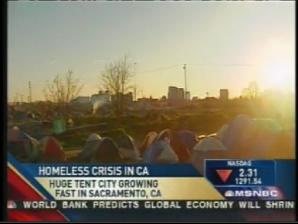MSNBC has been reporting on the huge tent city forming outside Sacramento, including a remarkable photo essay on the encampment. Similarly, a Daily Mail piece offers more detail:
Mikkel Fishman at The Moderate Voice has more details on the economic and political background.
As Chris Jansing reports, this isn't the only "tent city" gaining in size: So are similar encampments near Seattle, and Reno, and Nashville. Down in Dallas, the need for an encampment is rising quickly.
In other words, by mid-summer, we may see these encampments around the country. And they deserve a name:
Bushvilles.
When Americans had to endure such hardships 80 years ago -- forming shantytowns made of wood shacks and canvas tents -- they named them in honor of the president who had done nothing to prevent the oncoming recession and ultimately Depression into which he had led them.
They called them Hoovervilles:

A Hooverville was the popular name for shanty towns built by homeless men during the Great Depression. They were named after the President at the time, Herbert Hoover, because he allegedly let the nation slide into depression. The term was coined by Charles Michelson, publicity chief of the Democratic National Committee.[1] The name Hooverville has also been used to describe the tent cities commonly found in modern-day America.
Homelessness was present before the Great Depression, and hobos and tramps were common sights in the 1920s, but the economic downturn increased their numbers and concentrated them in urban settlements close to soup kitchens run by charities. These settlements were often formed on empty land and consisted of jerry-built shacks and tents. Authorities did not officially recognize these Hoovervilles and occasionally removed the occupants for technically trespassing on private lands, but they were frequently tolerated out of necessity. The New Deal had special relief programs aimed at the homeless, the Federal Transient Service (FTS), which operated 1933-35.
Some of the men who were forced to live in these conditions possessed building skills and were able to build their houses out of stone. Most people, however, resorted to building their residences out of box wood, cardboard, and any scraps of metal they could find, together with a stove, bedding and some cooking utensils.
Most of these unemployed residents of the Hoovervilles used public charities or begged for food from those who had housing during this era. Democrats coined other terms, such as "Hoover blanket" (old newspaper used as blanketing) and "Hoover flag" (an empty pocket turned inside out). "Hoover leather" was cardboard used to line a shoe with the sole worn through. A "Hoover wagon" was an automobile with horses tied to it because the owner could not afford gasoline; in Canada, these were known as Bennett buggies, after the Prime Minister.













